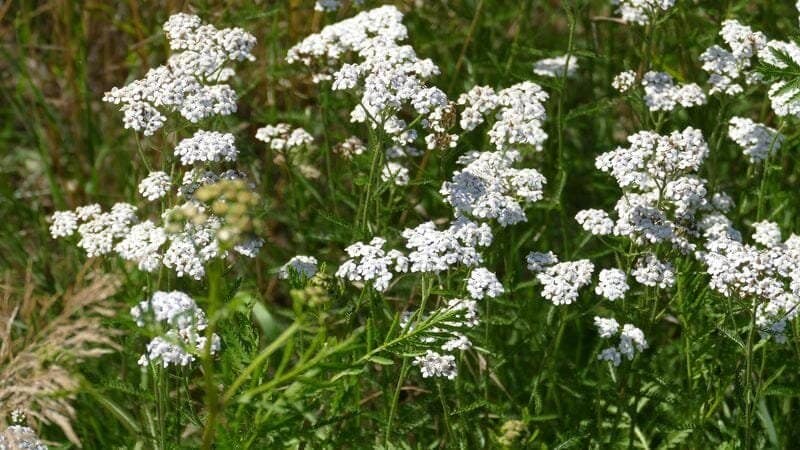Achillea spp. Yarrow Identification
Introduction
The ability to identify different species of Achillea, commonly known as yarrow, is a valuable skill for any plant enthusiast, ecologist, or herbalist to possess. Yarrow identification can be difficult because it is a diverse genus of flowering plants in the family Asteraceae, with over 100 recognized species found throughout the Northern Hemisphere. These hardy perennial herbs have a rich history of use in traditional medicine, cultivation as ornamental garden plants, and important ecological roles in their native habitats.
Properly identifying Achillea species and distinguishing between the different types of yarrow confers several key benefits:
Yarrow has been used medicinally for thousands of years to treat a variety of ailments. However, the phytochemical composition and therapeutic properties can vary between species. Accurately identifying the species ensures the correct type of yarrow is selected for specific herbal remedies and limits the risk of misidentification.
Different yarrow species have adapted to a range of habitats and environmental conditions. Being able to identify the various species provides insight into the ecology of an area and the interrelationships between yarrow and other flora and fauna.
This knowledge is vital for conservation, habitat management, and scientific research.
Ornamental landscaping: Many Achillea species are prized as attractive, low-maintenance additions to gardens and landscaping. Each species offers unique aesthetic qualities, such as flower color, leaf texture, and growth habit. Properly identifying the different species allows gardeners to select the optimal type of yarrow for their specific design intent and growing conditions.
Achillea species have limited geographical distributions or are considered rare. The ability to distinguish these less common species from the more widespread ones is crucial for documenting and protecting biodiversity. Accurate identification skills can aid in population monitoring, scientific studies, and conservation efforts.
Yarrow Identification - Achillea egyptica
Egyptian Yarrow; Nat. Ord. Compositæ.
This is an evergreen (though herb-like) perennial species. People have been growing this evergreen (in many areas) species for over 250 years, and it originally came, as its name implies, from Egypt. Notwithstanding the much warmer climate of its native country, it proves to be one of the hardiest plants in our gardens. I dare say many will think the Yarrows are not worthy of a place in the garden. Cut a long piece of stem and some foliage, and pushed into a deep vase for grand for indoor decoration.
A. egyptica not only produces a rich yellow flower, but the whole plant is ornamental, having an abundance of finely cut foliage, which, from a downy or nappy covering, has a pleasing gray or silvery appearance. The flowers grow on long stems nearly 2ft in length. high, furnished at the nodes with clean gray tufts of smaller-sized leaves; near the top, the stems are all but naked, and are terminated by the flat heads or corymbs of closely packed flowers. T
They are individually small, but the corymbs will be from 2in. to 3in. across. Their form is that of the common Yarrow, but the color is a bright light yellow. The leaves are 6in. to 8in. long, narrow, and pinnate, the leaflets of irregular form, variously toothed and lobed; the whole foliage is soft, from the nappy covering, as already mentioned. Its flowers, from their extra fine color, are very telling in a cut state. The plant is suitable for the borders, more especially amongst other old kinds. They like ordinary garden loam soil. Propagation may be carried out at any time by root division.
Flowering period, June to September.
Achillea filipendula
Nat. Ord. Compositæ.
This grows 4ft. It grows 4ft. high, and the foliage, though fern-like, has an untidy appearance because of the irregular way it is arranged. It is herbaceous and comes from the Caucasus. The flowers are singular, arranged in corymbs of a multiplex character; they are very large, often 5in. across. The smaller corymbs are arched or convex, causing the cluster or compound corymb to present an uneven surface; the small flowers are of rich old gold color and appear to be knotted gold cord; they are very rigid, almost hard.
Leaves are linear, pinnate, lobed and serrated, hairy, rough, and numerously produced. The untidy and tall characteristic of this subject suggests that it should be placed in the background when planted. It will last for several weeks after being cut, and even out of water for many days.
A few heads placed in an old vase, with no other flowers, are rich and characteristic, while on bronze figures and ewers in a dry state, and more especially against ebony or other black decorations, it may be placed with a more than floral effect. In short, rough as the plant is, it is worth growing for its quaint and rich flowers alone; Soil and propagation, the same as for A. egyptica.
Flowering period, June to September.
Achillea millefolium
Common Milfoil; Nat. Ord. Compositæ.
Picture above. This is the well-known wild Yarrow; it is, however, the typical form of a fine variety, called A. m. roseum, having dazzling rose-colored flowers, which in all other respects resembles the wild form. Both as a border subject and for cutting purposes, I have found it useful; it flowers for several months, but the individual blooms fade in four or six days; these should be removed regularly. The freshly opened corymbs are much admired. Soil and mode of propagation, the same as for previous kinds.
Flowering period, June to November.
Achillea ptarmica (Sneezewort)
Syns. A. sylvestris and ptarmica vulgaris; Common Names, Wild Yarrow, Sneezewort, Goose-tongue, and Wild Pellitory; Nat. Ord. Compositæ.
A very common British plant, or, I may say, weed, which can live in the most reeky towns, only mentioned here to introduce A. P. fl.-pl., which is one of the most useful of border flowers. I am bound to add, however, that only when in flower is it more presentable than the weedy and typical form; but the grand masses of pure white bachelors'-button-like flowers, which are produced for many weeks in succession, render this plant deserving of a place in every garden.
History
It is an ancient flower in English gardens. Some 250 years ago, Parkinson referred to the double flowering kind, in his "Paradise of Pleasant Flowers," as a then common plant; and I may as well produce Gerarde's description of the typical form, which answers for the double one, except for the flowers themselves:
"The small Sneezewort has many round and brittle branches, beset with long and narrow leaves, hacked about the edges like a saw; at the top of the stalks grow small single flowers like the field Daisy. The root is tender and full of strings, creeping far and abroad into the earth, and in a short time occupied very much ground." Yarrow identification is important with this species. The flowers of this plant are often, but wrongly, called "bachelors' buttons," which they much resemble.
Flower Arrangements
For cutting purposes, this plant is one of the most useful; not only are the blooms a good white, but they have the quality of keeping clean, and are produced in greater numbers than ever I saw them on the single form. Those requiring large quantities of white flowers could not do better than give the plant a few square yards in some unfrequented part of the garden; any kind of soil will suit it, but if enriched the bloom will be all the better for it.
The roots run freely just under the surface, so that a large stock may soon be had; yet, fine as are its flowers, hardy and spreading as the plant proves, it is but seldom met with. Even in small gardens, this fine old flower should be allowed a little space. Transplant any time.
Flowering period, June to August.
Enjoy your Yarrow. Plant several and since they are perennial, enjoy them year after year. Divide them in fall and more to enjoy.


